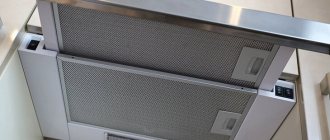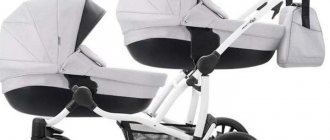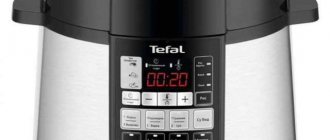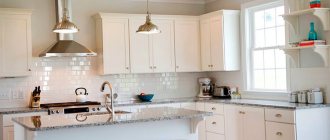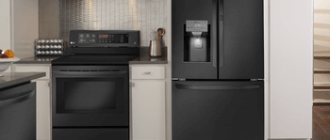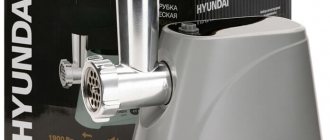For many housewives, the most familiar is considered to be a standard hood over the stove with a volumetric pipe on top - a fireplace type. However, technology does not stand still, and an inclined hood is already on sale, which significantly saves space. We’ll talk further about what its advantages are over classic models, what features and functions it has, and also go through the most popular brands of inclined kitchen hoods.
How to choose a sloped hood for the kitchen
The rules for choosing an inclined hood are generally standard. You need to look at the main technical characteristics of the models - it is necessary that they best meet individual needs.
Power
An inclined hood must first of all have sufficient power to clean the air in the room. Typically, the required productivity is determined as follows: multiply the kitchen area by its height to get the volume, and add about 20%.
The width of the kitchen hood should be no less than the stove
Filters
Any kitchen hood is equipped with a metal filter that traps fat particles. In addition, the device can be equipped with carbon purification systems that remove odors and eliminate microorganisms from the air. It is advisable that the model be equipped with two types of filters at once.
Noise level
An inclined hood cannot operate silently, but the hum should not be too loud. Models with a noise level of about 35-45 dB are considered quiet. If the hum exceeds 50-60 dB, then when the equipment is turned on, you will not be able to talk or watch TV calmly.
Additional options
Since an inclined air cleaner can partially obscure the hob, backlit models should be preferred. A filter clogging indicator will be useful; it will indicate that it is time to change or wash the cleaning elements.
Useful features
In very small kitchens, when every centimeter is important, hoods that save space will be very useful. There will no longer be a bulky appliance hanging over the stove, limiting access to the food being cooked.
New generation purifiers, in addition to the listed advantages, have a number of useful functions:
- ventilation system;
- sleep timer;
- auto-on (infrared temperature detectors will tell the device when cooking has started);
- automatic power adjustment (depending on the intensity of evaporation, the purifier operates in one mode or another).
The changes also affected the display: it also became more modern – touch-sensitive. With one touch of your finger you can set this or that function on it. But push-button hoods are not a thing of the past; they can also be found on sale.
Tips before purchasing
You probably know the dimensions of your hob; if not, you will need to measure it. Depending on the width, choose models of standard dimensions of 90 or 60 cm. The choice of matching sizes of tiles and hood is made not only for beauty, but also for efficient operation. The pulling surface should not be narrower, otherwise it will not cope with its task. And installing a purifier that is too wide with a narrow slab is impractical in terms of energy costs.
A mixed type of appliance with ventilation and recirculation allows for cleaning in one way or another. If your kitchen does not have a vent, a filtration hood will be your only option for removing contaminants from the air.
As practice shows, most buyers are already switching to inclined hoods, despite the fact that they are more expensive than usual. It’s better to pay once, but then enjoy the flawless operation of the device for many years, without cluttering up the extra space above the stove. If you don’t know which hood to choose, check out the top best devices of 2021 - you might like one of the models.
Hood sizes
Contents: 1. Standard sizes of hoods 2. Large and small exhaust systems 3. Dimensions of built-in units 4. Dimensions of inclined ones 5. Parameters of dome hoods 6. What are the corner models 7. Dimensions of round ones 8. Dimensions of island hoods 9. How to choose the size
A modern, clean kitchen is impossible without a range hood. Clean air, complete removal of grease and soot from the room - these are the two main purposes of this device. They are especially relevant for white rooms, as well as where there are many open storage systems.
In addition to the minimum distance from the stove to the grease removal panel, it is necessary to take into account the dimensions of the device. They influence the installation method, as well as the integration into ventilation. Incorrect connection may reduce performance and may also cause damage.
Standard hood sizes
The standard dimensions of all types of hoods, without exception, are tied to the parameters of the hobs. The grease collection panel should be slightly larger than or equal to the width of the slab, otherwise the efficiency will leave much to be desired, particles of grease and steam will settle on all surfaces and require more frequent cleaning.
The size range is as follows: 30, 40, 50, 60, 80, 90 cm. Accordingly, they are divided into large, standard (60 cm), and small. If you have a regular stove with 4 burners, then you can’t go wrong by choosing a device 60 cm wide and 50-55 cm deep.
The depth can vary, and in order not to make a mistake, it is better to take a large inclined one or with a retractable panel - they are guaranteed to cover the required area. For large rooms, in particular kitchens combined with a living room or dining room, we recommend choosing devices with a perimeter suction function.
Large and small exhaust systems
Minimum width standards start from 14 cm. These are models built into the table with great depth and height. For domino panels, the width of which is usually 19-20 cm, it is customary to buy the smallest 30 cm wide. Narrow hoods 40-45 cm wide are chosen for installation above 3-burner hobs.
Hoods 80-90 cm are considered large, although there are larger models with a width of 110 cm, for example, wall-mounted Smeg KTR110XE or Smeg KT110PE. These are semi-professional and professional devices with high performance and 2-4 grease filters. Usually these are installed above a stove with 5-6 burners, the width of which is also 80-90 cm.
Dimensions of built-in units
Built-in models are similarly tied to the parameters of the hobs. The smallest have a width of 30-45 cm, the standard 60 cm, the large ones - 80-90 cm. The depth is often equal to the width; if the device has a retractable panel, then it is half as much, so that it is convenient to build into hanging cabinets. Typically these are recirculation models, which are also characterized by their low height but excellent performance. As for the height, it depends on the specific species. The parameters of built-in models are covered in more detail in the article “Dimensions of built-in hoods.”
Sloping dimensions
Inclined models are characterized by high productivity due to their design features. The air flow passes faster, which means the room is cleaned faster. It is precisely because of their design that their size range is quite small: devices with a width of 60-90 cm are produced. Some manufacturers offer 50-centimeter devices, but they are not very popular.
Dome parameters
Dome hoods are some of the largest; there are models with a width of 120 cm, although the size grid starts from 30 cm. There are corner fireplace models, so they are often chosen for small-sized kitchens. The most popular ones are 60 and 80 cm wide; they are also among the most affordable, unlike inclined ones, for example.
When choosing a fireplace device, it is necessary to take into account the height, the maximum limit is 125 cm, otherwise the work will be unproductive and ineffective.
What are the corner models?
There are currently 2 types of corner models available:
- dome (aka fireplace);
- T-shaped.
The range of such devices is not very large due to their specificity; more often the hob is still made the center of the working triangle.
The size range also cannot boast of extensiveness: width from 50 to 90 cm. Sizes of round
Round hoods have high efficiency and greater productivity due to the features of their geometric shape. They are quite easy to install, they are lighter than their wall-mounted and built-in square counterparts, and there are devices with beveled edges. But due to design, they do not fit many styles, so they are less common. The minimum width starts from 40 cm; models with dimensions of 45, 50, 60 cm are quite popular.
Island dimensions
Island hoods can also be built-in, and the following parameters are valid for all options: width from 90 to 120 cm, height from 80 to 125 cm. There are models with a lifting-lowering mechanism, but their cost is from 100 thousand rubles. The depth usually varies from 50 to 70 cm.
How to choose the size
As we have already mentioned, the main selection criterion is the width of your hob. The suction blade (not the body, but the blade) must have the same parameters or be 5 cm larger.
In addition to size, the number of speeds and suction power at a minimum are important. Why at the minimum? Because the first one produces the least noise, this is important for those who have small children at home or the habit of cooking at night. There are special calculation formulas for optimal power in relation to the volume of the room.
Review of popular models
Krona Simona-600
One of the quietest series of the Italian brand, producing about 44 dB, although its productivity is above average (900 m3/h). The design provides touch control, 3 speed modes, a grease trap contamination indicator and a pair of halogen lamps. There are simply no bad reviews about it - the equipment is really high quality and easy to use. However, housewives are talking about this inclined model, which turns on the filter indication even when it is slightly dirty. The cost is about 36 thousand rubles.
Zorg Fabia
Zorg Technology offers a solution that is cheaper and at the same time much more effective. The Fabia model, with the same width of 60 cm, has a capacity of 1000 m3/h and 5 operating modes. But its noise level is noticeably lower - only 34.5 dB. Black metal against the background of a milky-white decorative screen gives the inclined hood an original look. All this splendor costs 33 thousand rubles.
Gorenje DVG 65W
The hood, which has earned rave reviews from its owners, impresses not only with its stylish white design, but also with its very quiet operation and a very serious productivity of 720 m3/h. At the first speed it is practically silent, its sound becomes audible at the third, and only at the maximum it reaches 66 dB. An excellent combined model with touch control for owners of kitchens with an area of 20-25 m2. Price – 27,500 rub.
Pyramida BT-600
The popular and almost “folk” brand Pyramida was one of the first to enter the market of affordable equipment with its inclined hoods. The BT-600 model turned out to be very easy to use and therefore included in our review. Its main difference from many more famous systems is the non-standard design of the door, behind which the filters are hidden:
- It is completely independent and opens without any effort with a simple press.
- There is no need to hold it with your hand during maintenance - there are special stops for this.
- In the working position, the door is recessed into the housing, barely protruding beyond its plane.
Pyramida BT-600, thanks to the built-in motor with a double impeller, has a good performance of 850 m3/h. Quite quiet - at the maximum third speed it produces a sound no louder than 49 dB. The only weak point that owners note in their reviews is the poor placement of the backlight. The hood body itself prevents full illumination of the hob. Price – about 15 thousand rubles.
The future clearly belongs to wall-mounted vertical exhaust systems. They are no longer inferior to bulky umbrellas of dome models, superior to them in ergonomics and appearance.
We just have to wait until the price of new equipment reaches an acceptable level, and inclined hoods will displace the snarling “monsters” of the first generation from our kitchens.
